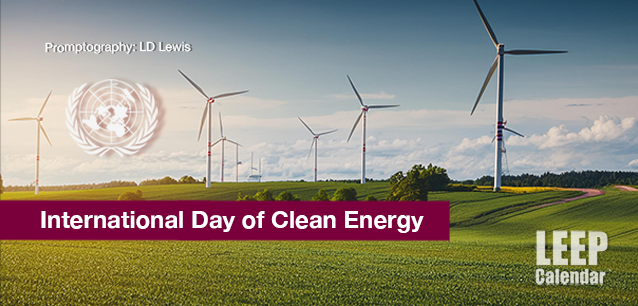 AD
AD
Today is: November 13
Scroll to explore events active on this date.
LEEP INK FEATURES

August? Absolutely!
In August, we live through the Dog Days of Summer. It's hot and often humid, and those who can leave for better climates do. Down south, winter is in full force. August is also known as "the ...

In The Heat of July: July 2025 Events
Is it hot enough (or cold enough if you're below the equator) for you yet? There is actually a day for that! Like every month, I pick a diverse collection of events you may or may not know about. This ...

May Blooms: Events in May 2025
Along with October, May is one of the most densely packed months of the year. It's before the summer humidity and the last whole month of the school year. The weather is warming in t...
About International Day of Clean Energy
Transportation , Lifestyle
Ends: Jan 26, 2024
DESCRIPTION:
TOWARD A BRIGHTER FUTURE
INTERNATIONAL DAY OF CLEAN ENERGY
The International Day of Clean Energy is an annual observance that promotes the adoption and development of clean energy sources worldwide. The day aims to raise awareness about the importance of transitioning to sustainable energy solutions to combat climate change, reduce pollution, and ensure a healthier planet for future generations. International organizations, including the United Nations, environmental NGOs, and clean energy advocacy groups, support this event.
Clean energy, also known as renewable energy, is derived from sources that do not deplete natural resources or cause significant environmental harm. It encompasses technologies and processes that harness natural phenomena, such as solar radiation, wind, hydrological cycles, geothermal heat, and biological processes, to generate power.
Clean energy systems are characterized by their low or zero emissions of greenhouse gases and other pollutants, making them environmentally sustainable alternatives to conventional fossil fuel-based energy production. This definition aligns with the principles of sustainable development, aiming to meet current energy needs without compromising the ability of future generations to meet their own needs.
The primary purpose of the International Day of Clean Energy is to highlight the benefits of clean energy, encourage investments in renewable technologies, and advocate for policies that support the global shift towards sustainable energy. It serves as a platform for governments, businesses, and individuals to showcase their commitment to reducing carbon emissions and promoting a greener future.
IMPORTANCE OF CLEAN ENERGY
Clean energy is crucial for several reasons:
—Environmental Protection
Reducing reliance on fossil fuels helps decrease greenhouse gas emissions, mitigating the impacts of climate change and reducing air pollution.
—Health Benefits
Cleaner air leads to fewer health problems, such as respiratory diseases, and improves public health.
—Energy Security
Diversifying energy sources reduces dependence on finite resources and enhances energy security.
—Economic Growth
The clean energy sector generates jobs, stimulates technological innovation, and contributes to economic growth.
A SHORT HISTORY OF CLEAN ENERGY
The history of clean energy dates back to the early 19th century when the first experiments with solar power and wind energy began. However, significant advancements in clean energy technologies have occurred over the past few decades, driven by increasing concerns about climate change and environmental degradation.
In the 1970s, the oil crisis highlighted the vulnerabilities of fossil fuel dependence, leading to renewed interest in alternative energy sources. Since then, technological advancements, government policies, and international agreements, such as the Paris Agreement, have accelerated the development and adoption of clean energy solutions.
TOP FIVE CLEAN ENERGY ALTERNATIVES
—Solar Power
Solar energy harnesses the sun's power through photovoltaic cells or solar thermal systems. It is one of the fastest-growing clean energy sources, offering a sustainable and abundant electricity supply.
—Wind Power
Wind turbines convert wind kinetic energy into electricity. Wind power is a mature technology with a significant capacity for large-scale energy production.
—Hydropower
Hydropower generates electricity by using the energy of flowing water. It is a reliable and established clean energy source, particularly in regions with abundant water resources.
—Geothermal Energy
Geothermal energy taps into the heat from the Earth's core to generate electricity and provide heating. It is a consistent and low-emission energy source.
—Biomass Energy
Biomass energy is produced from organic materials, such as agricultural residues, wood, and waste. It provides a renewable and versatile energy source for electricity, heat, and transportation fuels.
CONSEQUENCES OF NOT MIGRATING TO CLEAN ENERGY
Failing to transition to clean energy in the next 100 years could have catastrophic consequences:
—Accelerated Climate Change
Continued reliance on fossil fuels would lead to higher greenhouse gas emissions, exacerbating global warming and more frequent and severe weather events, rising sea levels, and disrupted ecosystems.
—Environmental Degradation
Increased pollution from fossil fuel combustion would lead to more severe air and water quality issues, harming wildlife and natural habitats.
—Health Crises
Higher pollution levels would contribute to respiratory and cardiovascular diseases, increasing healthcare costs and reducing quality of life.
—Resource Depletion
Finite fossil fuel resources would become increasingly scarce and expensive, leading to economic instability and energy insecurity.
—Economic Risks
Delaying the transition to clean energy would hinder economic growth, as countries needing sustainable technologies may miss out on the financial benefits of the burgeoning clean energy market.
The International Day of Clean Energy is a critical reminder to embrace clean energy solutions to ensure a sustainable, healthy, and prosperous future for all.
VIDEOS
SUPPORTING DOCUMENTS
Currently, this event does not have supporting documents.
ADDITIONAL IMAGES
Currently, this event does not have supporting images.
Where would you like to go now?
 AD
AD


/footer-logo.svg)
